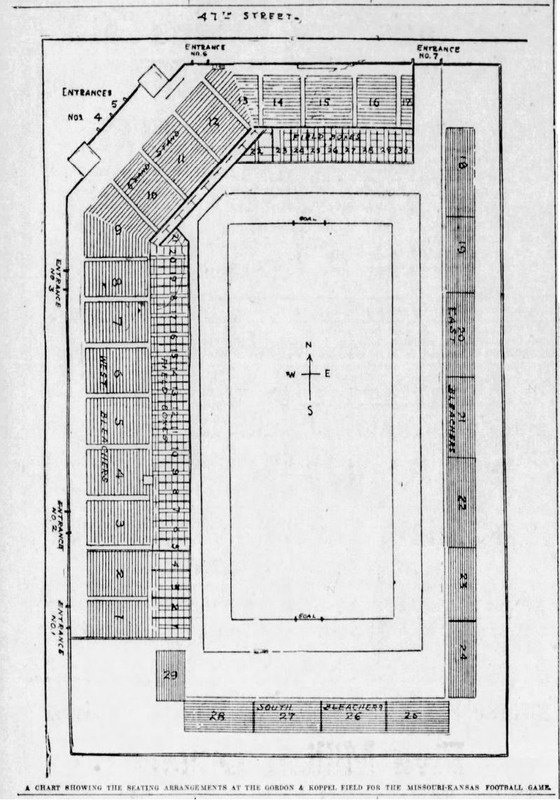Federal League Park (a.k.a. Gordon and Koppel Field)
Introduction
Text-to-speech Audio
Opened in 1910 by sporting goods retailers Arthur F. Gordon and Hugo M. Koppel, this ballpark operated until 1917 and was notorious for flooding. Known initially as Gordon and Koppel Field and later as Federal League Park, this stadium hosted baseball games as well as football, including a legendary game between the University of Kansas and University of Missouri. The stadium was just south of what was then 47th Street and home to the Kansas City Packers baseball team when they joined the Federal league in the spring of 1913. The Federal League was short-lived, lasting only two seasons, but during those years it was one of three organizations whose members were considered a Major League team. The Packers’ first game was played on 16 April 1914 and the team's last game was played on 28 September 1915.
Images
Diagram of the stadium from Kansas City Times, November 16, 1910

Backstory and Context
Text-to-speech Audio
The Federal League was the brainchild of James A. Gilmore, a coal and paper executive. Kansas City joined the league in mid-season, replacing the Covington, Kentucky franchise, which had been representing an unresponsive Cincinnati area.
A mid-season replacement team in the league’s inaugural minor-league season of 1913, the Kansas City Packers were a true dark horse for its concluding one. Finishing a distant sixth place (67-84, 20 games out of first) in 1914, the franchise had barely survived the offseason, losing their ballpark to a flash flood in the waning days of the previous campaign, and just staving off the league’s attempt to move them to Newark. In the wake of those maneuverings, the Indianapolis franchise was transferred instead of Kansas City. Expected to finish again in the bottom of the standings, the Packers were the surprise team of the 1915 season, leading the league for a large part of the way, contending until the last few weeks. They never let up through the entire season.
The Packers finished fourth, 5 1/2 games behind the Chicago Whales, with an 81-72 record, half a game better than the Newark Peppers, which finished 80-72. Kansas City would not see as high a finish by a white major league team for another 56 years. When the league practically went bankrupt in its initial campaign, Gilmore actively recruited players with major league talent with his own bankroll and stirred up enough interest to keep the league going for two more years. In the process eighty-one major leaguers jumped to the Federal League. The ballpark had an estimated capacity of 12,000. The team played in an era when teams in the Federal League and other Major and Minor Leagues were only open to white players, but other organized teams that were open to all were beginning to thrive such as the All Nations, a barnstorming team based out of Kansas City that was composed of native-born white Americans, African Americans, and recent Europeans.
Sources
Michael Benson. Ballparks in North America: A Comprehensive Historical Reference to Baseball Grounds, Yards and Stadiums, 1845 to Present. Jefferson, NC: McFarland Publishers, Inc. 1989.
Philip J. Lowry. Green Cathedrals: The Ultimate Celebration of all 271 Major League and Negro League Ballparks Past and Present. Reading, Massachusetts: Addison-Wesley Publishing Co., Inc. 1992
https://sabr.org/research/article/the-1915-kansas-city-packers/
https://en.wikipedia.org/wiki/Gordon_and_Koppel_Field#/media/File:KC_Gordon_Koppel_diagram_1910_11_16.jpg
